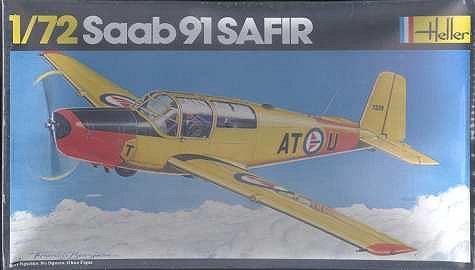
Heller 1/72 Saab Safir
| KIT # | 4901 |
| PRICE: | $ |
| DECALS: | One aircraft |
| REVIEW : | |
| NOTES: |
|

| HISTORY |
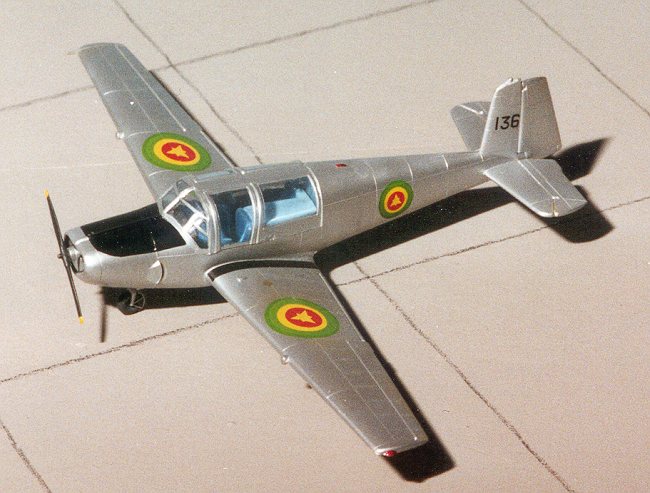
The Saab 91 Safir is a four seat cabin monoplane. It was firstflown in November 1945. A total of 320 Safirs were sold to customers in 20countries. Some were used as executive transports and others were sold to various military forces. Yet others were used for training airline pilots. The Saab 91B was powered by a Lycoming 190 hp, which was sufficient to give the aircraft good performance. A number of military Safirs were reduced to three-seaters by the addition of some avionics equipment that took up what was the fourth seat in the back of the aircraft. By all reports, the Safir was an easy to fly aircraft with no vices. To make it even safer in the event of an emergency landing, the nose wheel does not retract all the way and can help cushion awheels-up landing.
| THE KIT |
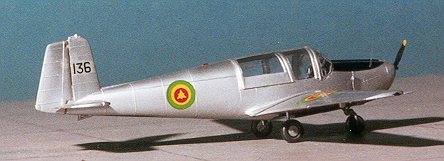 Heller's kit of the Safir
is really quite well done. My copy was molded in light blue plastic (!), but I
have seen kits molded in yellow and silver as well. All of the panel line
detailing is raised and there is good detailing for the rest of the kit. The full
interior has a nicely done tub with instrument panel, control wheels and seats.
No sidewall detailing is provided as it typical of kits of this era. There is
but one very large transparency that fits quite well and has well defined frame
lines to make painting easy.
Heller's kit of the Safir
is really quite well done. My copy was molded in light blue plastic (!), but I
have seen kits molded in yellow and silver as well. All of the panel line
detailing is raised and there is good detailing for the rest of the kit. The full
interior has a nicely done tub with instrument panel, control wheels and seats.
No sidewall detailing is provided as it typical of kits of this era. There is
but one very large transparency that fits quite well and has well defined frame
lines to make painting easy.
The instruction sheet is again, a typical Heller sheet with several construction steps. Color callouts are all in Humbrol paint numbers, but there is a conversion table that gives generic color names. Decals are quite matte and for a Norwegian Safir as shown on the box top.
| CONSTRUCTION |
Building this kit is a very straight-forward affair. I started with the interior. I had no clue as to what color to do the interior, so left much of it in the color of the plastic. I figured that for what is basically a civil aircraft, that blue wouldn't be too bad! The seats were painted a different shade of blue to sort of add to the effect. The cockpit fit into the fuselage quite well. Before gluing the halves together, I jammed as much weight into the nose as I could. This aircraft has a very short-coupled landing gear and most of the weight is aft of the main gear.
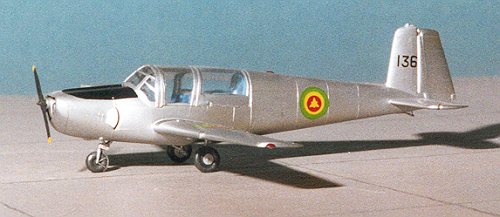 The wings are a three piece construction,
with the lower wing section reaching out to about 2/3rds span. This leaves
a seam that will need attention to eradicate. I wasn't as successful as I would
hope. However, that wasn't a problem at the time. This kit was built in October
of 1985. Back then, my focus was on output, not quality. During that month alone, I had completed 16 kits, so you can see that the production line was running hot and heavy!!
The wings are a three piece construction,
with the lower wing section reaching out to about 2/3rds span. This leaves
a seam that will need attention to eradicate. I wasn't as successful as I would
hope. However, that wasn't a problem at the time. This kit was built in October
of 1985. Back then, my focus was on output, not quality. During that month alone, I had completed 16 kits, so you can see that the production line was running hot and heavy!!
Attachment of the wing to the fuselage required a touch of filler, though none was used for the tail planes. Next, the landing gear struts were installed. The nose strut has the nose wheel as an integral part. At this time the kit was masked and ready to paint.
| PAINT & DECALS |
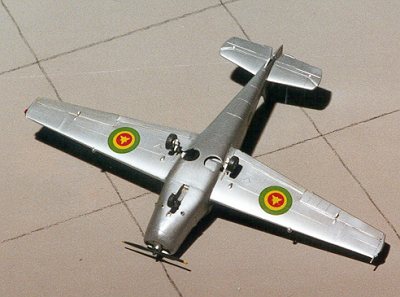 During this time of my modeling 'career', I was into doing aircraft of different nations. One I didn't have
was Ethiopia. What I did have was an old William Green book on Air Forces of the
World. It has a 1958 date on it so has a lot of older aircraft photos init, and one of them was an Ethiopian Safir. The aircraft was rather plain
being in overall aluminum or aluminum paint with nothing more than tail numbers
and insignia.
During this time of my modeling 'career', I was into doing aircraft of different nations. One I didn't have
was Ethiopia. What I did have was an old William Green book on Air Forces of the
World. It has a 1958 date on it so has a lot of older aircraft photos init, and one of them was an Ethiopian Safir. The aircraft was rather plain
being in overall aluminum or aluminum paint with nothing more than tail numbers
and insignia.
I had a set of decals that had Ethiopian roundel son it and a Modeldecal sheet that had serial numbers of the right size and similar font to that of the pictured aircraft.
Once the kit was painted aluminum (using Testors Aluminum Metallizer), it was a simple matter to affix the decals. At this time I also made a black decal for the anti-glare panel as masking Metallizer was an exercise in how to pull up paint. At that time, I had not yet started to undercoat Metallizer with gloss paint.
Once that was done and the paint dry, it was coated with clear. I think I used Testors Glosscote, but won't swear to it. The last thing to do was to paint thetires black and that was it.
| CONCLUSIONS |
The Safir really is a cute little kit. It is quite easy to build, as are most
of the Heller 1/72 kits of the time. The use of Ethiopian decals makes it stand out a bit more from the usual run of Safir kits that you see!
| REFERENCES |
Jane's Encyclopedia of Aviation, 1989
Review kit courtesy of me and my wallet!
Copyright ModelingMadness.com. All rights reserved. No reproduction in any form without express permission from the editor.
If you would like your product reviewed fairly and fairly quickly, please contact
the editor or see other details in the
Back to Reviews Page 2017